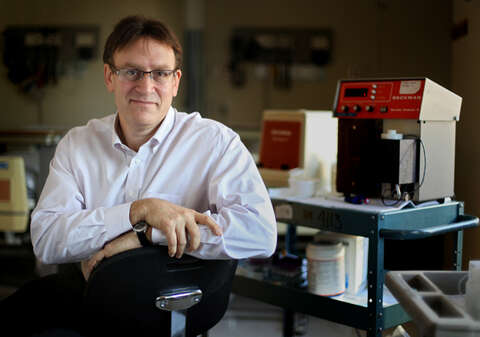Main Second Level Navigation
- Welcome
- Why Toronto?
- History of the Department
- Vision & Strategic Priorities
- Our Leadership
- Our Support Staff
- Location & Contact
- Departmental Committees
- Department of Medicine Prizes & Awards
- Department of Medicine Resident Awards
- Department of Medicine: Self-Study Report (2013 - 2018)
- Department of Medicine: Self-Study Report (2018 - 2023)
- Communication Resources
- News
- Events
Whither the Cure?

Jim Oldfield

“The pancreas,” says Professor Gary Lewis, an endocrinologist at Toronto General Hospital and director of the Banting & Best Diabetes Centre at the Temerty Faculty of Medicine, “is like an exquisitely sensitive and perfectly networked computer.”
Second by second, he notes, the pancreas secretes just the right amount of insulin or glucagon to lower or raise blood sugar — into the portal vein that leads directly to the liver, site of key metabolic processes — then distributes insulin to every tissue in the body via general circulation.
“Insulin injections are life-saving, but administered under the skin and nowhere near as precise,” says Lewis, who is also a scientist and professor of physiology and medicine at U of T. “It’s extraordinarily difficult to mimic the function of a healthy pancreas.”
That’s one reason a cure for diabetes has proven elusive almost 100 years after the discovery of insulin. Another big reason is the complexity of how the disease arises.
In type 1 diabetes, the immune system destroys the insulin-producing beta cells of the pancreas, creating a life-threatening spike in blood sugar.
“Progress on treatments has been fantastic, especially for type 2 diabetes”
Type 2 diabetes usually comes on more slowly, as the body becomes resistant to insulin or the pancreas can’t produce enough of it.
Genetics play a role in both types. Exposure to viruses and other environmental effects may be a factor in type 1. Lifestyle factors, including weight gain and physical inactivity, are strongly linked to type 2.
The bottom line, says Lewis, is that diabetes is a multifactoral disease, and we’re not close to a cure.
Ask about treatments, though, and Lewis gets excited.
The last two decades have brought a plethora of clinical and research advances, from new drugs to boost and sensitize the body to insulin and promote weight loss, to lifestyle interventions that improve diet, continuous monitoring of blood sugar, long- and short-lasting insulin, better insulin pumps, pancreatic transplants, and preclinical stem cell and immunosuppressive therapies.
“Progress on treatments has been fantastic, especially for type 2,” Lewis says. “I’m very, very hopeful.”
The distinction between treatment and cure in medicine is often unclear. And for the 3.6 million Canadians living with diabetes, that distinction matters less and less, if the goal is a full and healthy life.
Type 2 diabetes accounts for about 90 per cent of diabetes cases in Canada. Prevalence is rising, but Canadians with type 2 diabetes are living longer and have fewer diabetes-related complications.
“The clinic doesn’t look like it did 30 years ago,” says Lewis, who mainly treats patients with type 2. “We see fewer amputees, less blindness. Patients are generally healthier, and their prognosis is often excellent if they maintain their blood sugar target and other key parameters.”
Weight loss is a cornerstone of treatments to lower blood sugar, and recent research has strengthened the link between weight reduction and type 2 diabetes management. Some people with type 2 can lose weight and control blood sugar through dietary changes and exercise alone.
Bariatric surgery is very effective for weight loss and often results in diabetes remission, although it comes with surgical risks and is expensive.
“If we could prevent obesity, we could greatly reduce the incidence of type 2,” Lewis says. “And experiments have shown we can get a remission with lifestyle changes, so we know what works.”
The problem is broad implementation.
“I’ve tried to lose weight and I know how difficult it can be, especially in an environment of convenient and inexpensive calories,” Lewis says. Moreover, factors such as income, education, ethnicity, access to healthy food and living conditions can make lifestyle changes that curb obesity nearly impossible.
“Social determinants of health are overwhelmingly the most important influence on who gets type 2 diabetes, and how well or poorly they do with it,” Lewis says.
Fortunately, dozens of new drugs for diabetes have hit the market in the last two decades.
Medications for weight loss round out the armamentarium, and some also protect against kidney damage and lower cardiac risk. Current therapies can reduce body weight up to 10 per cent, although a loss of 20 per cent or more would have a greater effect on outcomes for patients with type 2 diabetes, says Professor Jacqueline Beaudry, an assistant professor of nutritional sciences at the University of Toronto who studies links between obesity, hormones and diet.
Beaudry is probing the biology that underpins these medications, including the gut hormones GLP-1 and GIP. They control blood glucose and reduce appetite, but scientists are unsure how. “If we could understand their mechanisms of action, we could design better drugs,” Beaudry says.
Recent advances in treating type 1 diabetes have also been striking.
Dessi Zaharieva was diagnosed with type 1 diabetes at age seven and has lived with it for 24 years. She says advice and therapies are more individualized today and that technology has radically changed the patient experience.
“It’s a sign of progress that now patients on continuous glucose monitoring sometimes resent a daily fingerstick blood test,” says Zaharieva, a postdoctoral scholar in exercise physiology and blood glucose management at Stanford University.
“As a child I had to test my blood every hour or so, then contend with big dips and spikes in glucose,” she says. “Before that, patients had to urinate on a stick. It’s easy to forget how far we’ve come.”
“It’s easy to forget how far we’ve come”
Zaharieva switched from insulin injections to a pump technology when she was 13. The change gave her better control of the hypoglycemia she experienced after exercise and helped her compete in martial arts. She later represented Bulgaria and Canada in taekwondo.
Today, Zaharieva uses a closed-loop system that some call an artificial pancreas. It includes the mobile app Loop, which takes blood sugar readings every five minutes, and based on an algorithm adjusts the insulin released by a pump. The system is connected by a device that translates radio signals to Bluetooth.
The system has improved her daily ‘time in range’ — how long she spends in the target glucose zone. It still requires user interaction, but future iterations may include automated inputs for carbohydrates such as photos of food, and motion sensors to detect exercise. A non-profit organization called Tidepool is now building an FDA-regulated version of Loop.
Cell therapy could prove more liberating still for people with type 1 diabetes. University labs and biotechs are working on implantable devices that house insulin-producing cells derived from stem cells.
To that end, Professor Cristina Nostro and her team in the McEwen Stem Cell Institute at University Health Network recently discovered a more efficient way to generate and purify pancreatic precursor cells from human stem cells in the lab.
They have also found a way to vascularize those cells by working with Professor Sara Vasconcelos, an assistant professor at U of T’s Institute of Biomedical Engineering. Together, they have extended the survival and functionality of the cells in animal models of diabetes.
The biggest problem with these therapies is that the immune system rejects them. The same challenge currently hinders pancreas and islet transplants.
“The immune system is an amazing machine, we’re lucky it’s so good,” says Nostro, who is an associate professor of physiology at Temerty Medicine. “But it’s very difficult to control when it goes awry, as in autoimmune conditions.”
Nostro is working with immunologists at the university on a method to protect insulin-producing beta cells from immune rejection, and she says many researchers in the field are now focused on immune-protective approaches.
Another strategy for type 1 diabetes is to tamp down the autoimmune response before the disease progresses. The idea is to prevent immune cells that damage the pancreas while the body still produces beta cells.
“Groups around the world are bringing different ideas and creative approaches to treat type 1 diabetes, that’s the beauty of science,” says Nostro. “I am very hopeful about what the future holds. Who knows? Maybe we will see hybrid technologies combining a pump and cells. We have to keep an open mind.”

